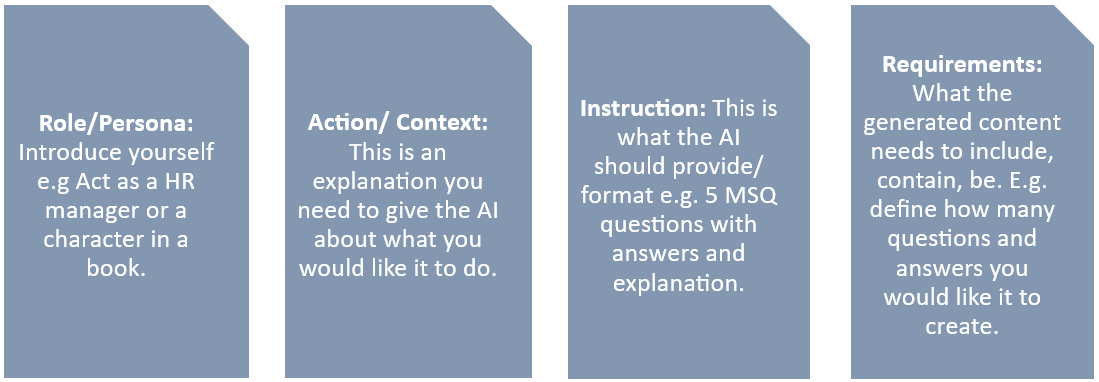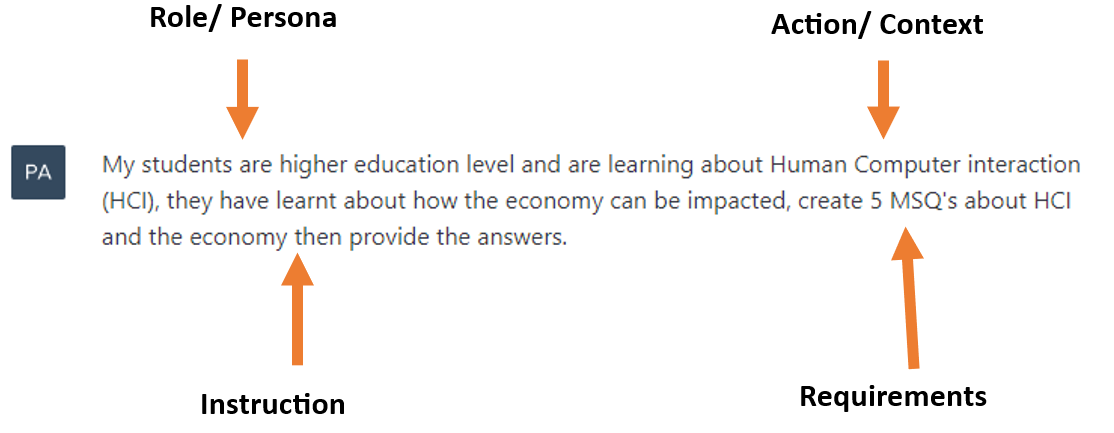A series of guides part 1 of 4
Diving into AI tools can sometimes feel a bit daunting, to help, we’ve created a blog series that aims to empower educators by providing them with the knowledge they need to use these tools effectively. First, we will look at how to get the most from prompting. Secondly, we will look at how to use some AI tools such as; ChatGPT 3.5 and 4, Microsoft Copilot and Google Gemini. Finally, we will demonstrate how to create some useful teaching content such as multiple-choice questions, scheme of work and assessment rubrics. This blog focuses on prompting.
What can generative AI do for educators?
Let us start with the basics: how can generative AI be a game-changer in education? It is more than just a high-tech tool; it is like an all-in-one assistant. From creating engaging teaching materials and easy-to-follow guides for complex topics, to assisting with research and crafting quizzes, AI has a lot to offer. It is all about leveraging technology to make teaching a bit easier and save time.
The secret to effective AI communication
Now, how do you get the most out of these AI tools? It is not just about what you ask, but how you ask it. Think of it as learning to be a chef, prompts are your ingredients when interacting with AI. Whether you are after detailed study guides, creative lesson ideas, or complex problem-solving, the prompt is your key to unlocking AI’s potential.
Just like a chef combines ingredients to create a delicious dish, you combine words to get the best response. The right prompts lead to more accurate, relevant, and useful content generation.
Prompt roles
When prompting, think about breaking it down into four categories: role/persona, action/context, instruction, and requirements.

- Role/Persona: Think of directing the AI, like a chef guiding a sous-chef to take on a specific role in the kitchen. For example, you could instruct the AI to assume the role of a pastry chef. This frames your interaction, giving the AI a specific persona to adopt, which makes your exchanges more focused and engaging.
- Action/Context: Here, you set the scene for the AI, similar to a chef explaining the day’s kitchen dynamics. You might outline a busy restaurant scenario or a calm prep session. This background is crucial as it informs the AI on the context and helps it tailor its approach accordingly.
- Instruction: In this step, you’re giving the AI specific cooking instructions, just like a chef detailing a recipe. Whether you’re asking for a set of quiz questions or an overview of a complex culinary technique, this is where you provide clear, concise directions.
- Requirements: This involves laying out the exact ingredients and quantities, if your recipe calls for five quiz questions with answers and explanations, this is where you spell it out, much like a chef detailing the length and steps of a cooking process.
Bringing it all together: By mastering these four roles, you can effectively communicate with the AI tool to create tailor-made educational content. It is about being clear, precise, and creative in your requests.
Example prompt role categories in action:

Here are some examples that you could follow to generate teaching and learning content.
Prompt examples:
Create:
Act as a [role e.g. University lecturer] and create a [requirements e.g. rubric] for [context e.g. assessment topic] in [subject areas] at the [level] based on [learning outcome] [Instruction e.g. on two sides.]
Act as a [role e.g. Team Manager], create a [requirements e.g. professional development plan] in a formal tone for [context e.g. customer services agents] in [industry] which is [instruction e.g. 2 pages long.]
You are a [role e.g. course leader], create a [requirements e.g. classroom management strategy] for [context e.g. level in a diverse learning environment], this plan will be for [one semester], [instruction e.g. and suggest solutions.]
You are an [role e.g Further Education skills lecturer], create a [requirements e.g. lesson plan for a 1-hour lesson] based on [context e.g specific topic] the [subject areas of] for higher education students. [instruction e.g with three assessment activities.]
You are a [role], create a [requirements e.g. word puzzle with 15 words] with a theme of [context e.g. specific topic] suitable for [age], [instruction e.g after designing the puzzle, also provide a solution key with the correct answers for each of the 15 words.]
You are a [role], create [requirements e.g. number of questions] [context e.g. questions from [topics]. The questions should become progressively more difficult according to Bloom’s Taxonomy of Learning [instruction e.g. and provide the answers.]
Outline:
You are a [role], outline a [requirements e.g. project-based learning activity] for [context e.g. level] students based on [subject/topic]. The outline will be for a 4-week project.
You are a [role], outline a [requirements e.g. student engagement strategy] for [context e.g remote learning] [instruction e.g. in a formal tone on one page.
Develop
You are a [role], develop a [requirements e.g quiz with 25 questions and answers] on the topic of [context e.g specific subject topic] with [instruction e.g. the questions need to become harder as the quiz progresses.]
Suggest
You are a [role e.g new to teaching], please suggest [requirements e.g assessment methods] [context e.g when planning a course for the next academic year, this course will be taught to [level] [instruction e.g. create this in a table] against [learning outcomes.]
What is conversational prompting?
Slightly different to the prompt role method. Conversational prompting is all about talking to an AI tool like it is a person. You are not just throwing commands or questions; you are engaging in a back-and-forth dialogue. You provide a question or a statement, and the AI tool responds, keeping the conversation flowing.
Conversational prompting in action
Let’s say you are discussing Shakespeare’s “Hamlet” with an AI tool. Start by asking, “Can you give me a summary of ‘Hamlet’?” Once it responds, follow up with, “How does Shakespeare portray the theme of revenge in the play?” then “How does Shakespeare use language to create tension in ‘Hamlet’? Following that, a good next question would be, “Can you give examples of this from the play?” and so on.
Tips for educational conversations with AI tools
- Start simple: Begin with a basic question or statement about a lesson topic.
- Follow the flow: Use the AI tool’s response to guide your next question, just as you would in a normal conversation.
- Encourage depth and detail: Push the conversation further by asking for explanations, examples, or even different perspectives.
Image prompting
Creating effective prompts for image generation involves being clear, detailed, and imaginative. Here’s an example of a good prompt:
“Imagine a serene beach scene at sunset. In the foreground, there’s a hammock tied between two palm trees, gently swaying in the breeze. The hammock is patterned with vibrant colours – blues, reds, and yellows. The beach is white and sandy, leading to clear, turquoise waters. In the background, the sun is setting, painting the sky in shades of orange, pink, and purple. There are seagulls flying in the distance, and a small, wooden boat is anchored near the shore. The entire scene evokes a sense of peace and relaxation.”
This prompt is effective because:
- Detailed Description: It includes specific details like the colours of the hammock, the state of the water, and the time of day.
- Atmospheric Elements: It sets a mood or atmosphere – in this case, peace and relaxation.
- Balanced Imagery: It has a good balance of foreground and background elements, creating depth in the image.
Remember, the more vivid and detailed your description, the more accurately the generated image will reflect your vision.
Poor prompting
We have looked at prompt types and how to get the most from AI tools, however, there are common prompt pitfalls such as;
- Vague and unclear – “Tell me about that thing”
- Overly specific without clear intent – “List all the words you know that start with ‘s’ and end with ‘e’.”
- Overly broad or general – “Explain everything about the universe “
- No context provided where it’s needed: “How can this be fixed?” (without explaining what “this” is)
- Assuming the AI has personal experiences or opinions: “What’s your favourite memory?”
- Questions with an inherent bias: “Isn’t it true that games are bad for kids?”
- Ambiguous or confusing: “What do you think of it?” (without specifying what “it” is)
Getting the hang of effective prompts with AI tools is a skill that comes with practice. As you become more comfortable with this, you will hopefully find that generative AI can generate useful content and could save time.
Using generative AI in education in a responsible way
Finally, it is important to be mindful of a few issues, especially regarding biases in AI models. These models learn from the data given, and this can shape the content generated. For instance, if an AI tool is trained on news articles written by men, it may develop a bias, unintentionally favoring male perspectives. Generative AI models can also produce hallucinations, which are false outputs, these are not based on the data the model was trained on. For example, a model may generate a poem that includes a made-up word or an image that includes an object that is not in the real world. This highlights the need for users to quality and fact-check generated content. When generating content, there are some questions to ask yourself.
Creativity: Does it demonstrate originality? Is the content a hallucination? Assess how creative and novel the content is.
Coherence: Does it make sense? Evaluate whether the content is logically structured and coherent.
Relevance: Does it address the intended purpose? Consider whether the content is relevant to the given task or prompt.
Quality: Examine the quality of the content in terms of grammar or image resolution. Double-check information independently and don’t rely on the AI tool’s responses.
Bias and Ethics: Are there any biases or ethical concerns present in the AI-generated content? Are there stereotypes, any offensive language, or inappropriate themes?
A word of warning, some generative AI tools collect user inputs for training their models. It is worth checking the terms and conditions when choosing which AI tool to use. We have published a blog post Navigating the terms and conditions of generative AI that explains this in more detail.
Additionally, the Department for Education has produced a policy paper called Generative artificial intelligence (AI) in education and it states:
- Do not enter any personal and special category data in accordance with the data protection legislation.
- Do not allow or cause intellectual property, including pupils’ work, to be used to train generative AI models without consent or exemption to copyright.
Be mindful of this before entering anything into an AI tool and update yourself on any and all policies surrounding the use of data.
What’s next?
Having explored prompting methods, our next blog as part of the Empowering Educators by Harnessing Generative AI Tools: How to use ChatGPT part 2 of 4 which will include how to create teaching resources and images using ChatGPT 3.5 and 4, Microsoft Copilot , and Google Gemini.
Find out more by visiting our Artificial Intelligence page to view publications and resources, join us for events and discover what AI has to offer through our range of interactive online demos.
For regular updates from the team sign up to our mailing list.
Get in touch with the team directly at AI@jisc.ac.uk
